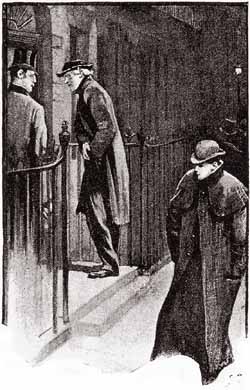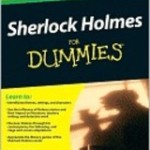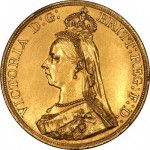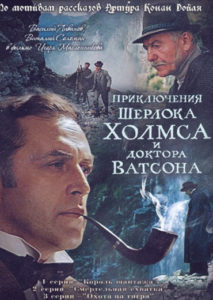A Scion Society of The Baker Street Irregulars

Data! Data! Data! – A Scandal In Bohemia
“‘Data! Data! Data!‘ he cried impatiently. ‘I can’t make bricks without clay.’”
– The Adventures of The Copper Beeches (COPP)

This column is composed of material (Data!) developed for a short course called Appreciating Sherlock Holmes that I teach twice a year in the Community Education Life Enrichment Program for a local community college. It is composed of “points of information” that are common to many / most / all of the 60 Canonical stories.
The information here has been researched by me or borrowed / stolen from many efforts of other Sherlockians.
READER BEWARE – This month we have some our longest list of items ever appearing in any of these articles – particularly, ANNOTATED SHERLOCK. Consider it a test.
HERE GOES This month’s story A Scandal in Bohemia
 CHRISTOPHER MORLEY SAID . . .
CHRISTOPHER MORLEY SAID . . .
“The first in a long series of shorter tales, and one of the most charming. Holmes relieves the King of Bohemia from an embarrassment, but finds the American prima donna Irene Adler more attractive than the royal client he is serving. Holmes outwits her first, but she retaliates brilliantly. He refuses to shake hands with the King of Bohemia and keeps Irene’s photograph as a souvenir. Perhaps the only evidence of romantic sentiment in the great detective’s career.”
 DUMMIES SHORT SUMMARY (From Sherlock Holmes for Dummies by Steven Doyle & David Crowder)
DUMMIES SHORT SUMMARY (From Sherlock Holmes for Dummies by Steven Doyle & David Crowder)
“Hired to thwart a public scandal involving the King of Bohemia, Holmes encounters the beautiful Irene Adler, who, as he puts it, “has the face that a man might die for”.”
PUBLISHING HISTORY
- This is the third of the 60 stories published
- In England, it was published in The Strand Magazine in July, 1891
- In the United States, it was part of the New York edition of The Strand Magazine in August, 1891, and was syndicated in seven newspapers across the U.S. before The Strand Magazine. They often changed titles so Woman’s Wit and the King’s Sweetheart in another.
- The Illustrator was Sidney Paget – his first Holmes story and he is the most famous of Sherlockian illustrators
HOW MANY WORDS?
According to C. E. Lauderback, 1960 – – found on SHERLOCKIAN.NET website. At 8,599 words SCAN has the 36th most words (#1 is VEIL – 4,499, #56 if NAVL – 12,701)
THE BEST OF SHERLOCK HOLMES (How do Sherlockians rate this story?)
This one is way up on everybody’s list of Favorites.
- 1927 – Arthur Conan Doyle said it was #5 on his list of 12 favorites
- 1944 – The Baker Street Irregulars voted it as #2 on their top 12 favorites
- 1954 – The Baker Street Irregular voted it as #3 on their top 12 favorites
- 1959 – The Baker Street Irregulars voted it #5 on their list of 10 favorites
CLASSIFYING THE CASE (From the Wandering Gipsies of Grimpen Mire of Decatur, Alabama)
This case is one of two classified as fear of physical harm or public scandal. The other is 3STU.
CHRONOLOGICALLY SPEAKING
Doyle was often very vague about stating WHEN the tale took place and included few contemporary references to help. Whether this was done intentionally or unthinkingly, the dating of events in the Canon is a very popular pastime pursued by several of our “scholars” researching and justifying their results to no end. We will again default to William Baring-Gould’s dating of Friday, May 20 to Sunday, May 22, 1887 making it 9th of the 60 stories in time. That would make Holmes 33 and Watson 35.
WHAT ELSE HAPPENED IN THE YEAR – 1887?
It is always interesting to see what else in happening at the same time as the stories.

- British East Africa Company charter awarded.
- Zululand becomes protectorate.
- Victoria’s Golden Jubilee, end of Windsor Retirement.
- Britain annexes Zululand.
- Irish Coercion Act; Irish Land Act.
- Charing Cross Road opens.
- Coal Mines Regulation Act, boys under 13 not to work underground, and under 12 at the surface.
- United States begins free mail delivery to homes of any community with a population of 10,000 or more.
China recognizes Portugal right to the island of Macao. - Renewal of Russo-German ‘Reinsurance’ Treaty; and Triple Alliance
- Italian force annihilated by Ethiopians at Dogali; designs on Tripoli conditionally supported by Britain and Germany.
- Union of Indo-China formed by France.
- Macao recognized as Portuguese by China.
- Yellow River floods in China, killing nearly a million people.
- S. Interstate Commerce Act, federal control of interstate railways.
- Conan Doyle’s A Study in Scarlet, first Sherlock Holmes story, published.
- Rider Haggard publishes She and Allan Quatermain.
- Cazanne paints The Blue Vase.
- Claude A. Debussy debuts Le Printemps.
- Monet paints Fields in Spring.
- Verdi debuts Othello.
- Radio waves discovered by Hertz.
- Bauxite, source of aluminum, is discovered in Georgia.
- Edison and Swan combine to produce ‘Ediswan’ electric lamps for domestic use
- Mach defines the Mach Number, now used in supersonic flight.
- Daimler four-wheeled motor car produced.
HOLMES AND WATSON – PERSONAL INFO
Holmes was living alone at 221B Baker Street. Watson and his wife Mary (from SIGN) and his medical practice are elsewhere.
DRAMATIS PERSONAE
- THE KING OF BOHEMIA aka COUNT VON KRAMM, Bohemia was never a kingdom
- CLOTILDE LOTHMAN, fiancée of the King and Princess of Scandinavia.
- IRENE ADLER, The Woman, Watson calls her “The Late Irene Adler” does not mean she was deceased by the time the story appeared in 1891, it probably means the change of the marital status and subsequent name change. (think of it as “formerly”)
- GODFREY NORTON, a prominent young attorney, engaged to Miss Adler.
- TURNER, Holmes’ landlady (in EMPT original manuscript “Mrs. Turner” is written and crossed out for Mrs. Hudson)
- MARY JANE, Watson’s servant girl.
“QUOTABLE SHERLOCK”
This is the first of the short stories establishes many things about our hero.
- Opening words – “To Sherlock Holmes she is always the woman”
- Watson’s Comment on Holmes – “He was, I take it, the most perfect reasoning and observing machine that the world has seen”
- Holmes to Watson – “You see, but you do not observe. The distinction is clear. For example, you have frequently seen the steps which lead up from the hall to this room.”
- Holmes to Watson – “It is a capital mistake to theorize before one has data. Insensibly one begins to twist facts to suit theories, instead of theories to suit facts.”
- Holmes to Watson – “There’s money in this case, Watson, if there is nothing else.”
- Holmes to Watson -I am lost without my Boswell
- Holmes to Watson – “She is the daintiest thing under a bonnet on this on this planet.”. So say the Serpentine-mews, to a man
- Holmes to Watson – “I only caught a glimpse of her at the moment, but she was a lovely woman, with a face that a man might die for.”
- Holmes to Watson – “The bride gave me a sovereign, and I mean to wear it on my watch-chain in memory of the occasion.”
- Watson on Holmes – “The stage lost a fine actor, even as science lost an acute reasoner, when he became a specialist in crime.”
- Holmes to Watson – “Women are naturally secretive, and they like to do their own secreting.”
- Irene Adler to Holmes – “Good-night, Mister Sherlock Holmes.”
- Watson on Holmes – “And when he speaks of Irene Adler, or when he refers to her photograph, it is always under the honourable title of the woman.”
HOLMES’ FEE
Sherlock Holmes says “Then, as to money?” The king replies “You have carte blanche.” The King also gives Holmes £300 in gold and £700 in notes up front for expenses. (This equals £67,000 today) Will Mrs. Hudson get more for her rent?
SHERLOCK ON THE BIG SCREEN & THE LITTLE SCREEN
As popular as the story is, one might think this would have been done more than listed here.
- 1921 A Scandal in Bohemia by Eille Norwood, the first ever to do a series of the stories. The National Film and Television Archive at the BFI has viewing copies of this film but it has not been released.
Sherlock Holmes ————————— Eille Norwood
Dr. John Watson ————————— Hubert Willis
Irene Adler ———————————- Joan Beverly
King of Bohemia ————————— Alfred Drayton
- 1983 The Russian series, Sherlock Holmes and Doctor Watson. It was the episode The Treasure of Agra starring Vasily Livanov. The story line combined both SIGN and SCAN.
- 1984 A Scandal in Bohemia was an episode in the BBC series Sherlock Holmes staring Jeremy Brett.
- 2012 A Scandal in Belgravia was an episode in the Sherlock series starring Benedict Cumberbatch. As with all stories in this series, it was a blend of SCAN and other contemporary things.
SHERLOCK HOLMES IN DISGUISE
The Master of disguise used the deception of being disguised 14 times in 11 of the 60 stories. In this story Holmes used a disguise twice He was a drunken-looking groom AND a non-conformist clergyman. Not to be outdone, Irene Adler also uses a disguise that fools Holmes.
UNRECORDED CASES (That involved Holmes)
Watson would tease / torture his readers with “I know something you don’t.” Oh my, how Sherlockians love this category. I have in excess of over 150 examples in my collection. In this story Holmes mentions prior, undocumented adventures.
- His summons to Odessa in the Trephoff murder
- The singular tragedy of the Atkinson brothers ar Trincomalee
- A mission he had accomplished so delicately for the reigning family of Holland
- The Darlington substitution scandal
- The Arnsworth castle business
IS THERE A DOCTOR IN THE HOUSE?
Victorian London, in the Holmes’ time, had approximately one doctor for every 100 people. 31 of the 60 tales have a doctor in them. This, of course, does not count Holmes’ Boswell. This listing is by Leslie Klinger in the Winter, 2015 edition of the Baker Street Journal. Whether it was Doyle or Watson, a doctor wrote the story. In this story there was no doctor involved or mentioned.
FAINTING IN THE CANON (courtesy of Sherlockian Karen Murdock)
Fainting is extremely common in the Canon, appearing, in some form, in 37 of the 60 tales. In 21 cases someone actually faints. In 22 cases someone almost faints. And in 5 cases someone pretends to faint. But, in this tale, no one faints, almost faints, pretends to faint, or even mentions fainting.
HOLMES’S PUBLISHED & PROJECTED WORKS
Sherlockians love this topic and are regularly searching for these items. Holmes mentions published or projected works in 11 of the stories but none are mentioned here.
NEWSPAPERS (Real and Fictional)
Though included in only 20 tales, some of our more obsessed Sherlockians love this one. No obsessions are satisfied in this story.
ANNOTATED SHERLOCK
The 60 Sherlock Holmes stories used English as spoken in England from the 1880’s until the 1910’s. Some words are foreign to us today and need a “contemporary translation.” Our story is replete with them, hence the long, long list. Would you believe that I took 15 items off my list. Welcome to the end of the 19th century.
- “It came by the last post.” In downtown London, in Holmes’ and Watson’s day, there were as many as 12 postal deliveries a day, and in Baker Street there were 6. Most people rarely received mail and didn’t dream of having a telephone. On Sundays there was no postal service, thus it was necessary to hire a Commissionaire or other special messenger.
- “a cabinet” was a photograph of 3 7/8 5 ½ inches in size. “Carte de visite” and “boudoir” are smaller sizes.
- “a landau” a two-seated, four-wheeled, covered vehicle with a top divided into two sections, the back could be let down or removed. Named for the German town where first manufactured.
- “an ordinary plumber’s smoke rocket” Device once used by plumbers to check for leaks in drains.
- “a spirit case or tantalus” is a stand containing usually three glass cut decanters, which, though apparently free, cannot be removed without the bar that engages the stoppers is raised. Many such have a padlock to the bar to avoid “tantalizing” the servants.
- “a gasogene” is a device that produces sparking soda water (seltzer).
- “slavey” is a term used for maid servants assigned primarily to the lowest duties.
- “ a brougham” A light enclosed carriage with seats inside for two or four.
- “an Astrakhan” is lambskin with cured wool, derived from Middle Eastern sheep; or a rough fabric made in imitation of this.
- “bijou” Small, marked by fine detail and workmanship.
- “mews” Short streets or alleys behind London’s main thoroughfares, originally referring to the stabling of horses.
- “half and half” A drink: half ale and half porter or other bitter beer.
- “hansom cab” These were two-wheeled carriages which seated two in the interior with the driver seated on the outside.
- “iodoform” a yellowish, crystalline, water-insoluble solid, CHI3, analogous to chloroform,and having a penetrating odor: used chiefly as an antiseptic.
- “nitrate of silver” a compound once used for decontamination of water.
- “Boswell” James Boswell, often referred to as simply Boswell, friend and biographer of Samuel Johnson.
- “a vizard mask” a MASK ‘which covers the whole face, having holes for the eyes, a case for the nose, and a slit for the mouth.’
- “chubb lock” — became the sole supplier of locks to the General Post Office and a supplier to Her Majesty’s Prison Service . . . they designed a special secure display case for the Koh-i-Noor diamond for its appearance at The Great Exhibition.
- “ostler” One who is employed to tend horses, especially at an inn.
- “Inner Temple” The Honourable Society of the Inner Temple is one of the four Inns of Court around the Royal Courts of Justice in London which may call members to the Bar and so entitle them to practise as barristers. (The other Inns are Middle Temple, Gray’s Inn and Lincoln’s Inn.)
- a “surpliced” clergyman — a loose-fitting, broad-sleeved white vestment, worn over the cassock by clergy and choristers.
- “ulster” a long, loose, heavy overcoat, originally of Irish frieze, now also of any of various other woolen cloths.
- civil practice: Watson has been a medical officer in the British Army; following his marriage in the previous Holmes adventure, The Sign of Four, he moves out of the rooms at 221B Baker Street which he shared with Holmes, and begins a non-military (“civil”) medical practice.
- four-wheeler: an enclosed carriage with four wheels and doors on both sides; the driver usually sat in the front on top.
- Non-conformist clergyman: all Protestant groups who choose not to associate themselves with England’s official Anglican church are called “non-conformist.”
- spirit case: a cabinet filled with flasks containing various distilled liquids and solutions.
- sally – rush out.
WEAPONS (from A Compendium of Canonical Weaponry by Dettman and Bedford)
… “a means by which one contends against another” … utilized in 57 of the 60 tales (all but CREE, 3STU, & YELL)
- Sticks – Of some of the personae in Holmes staged brawl outside Irene Adler’s home.
- Fists – Of some of the participants in Holmes’ staged brawl outside Irene Adler’s home, one of which supposedly struck Holmes (disguised as a kindly old non-conformist minister)
- Photograph – Taken, of the King of Bohemia with Irene Adler (its content makes for some interesting speculation), which “The Woman” threatened to send to the King of Scandinavia, whose daughter the impudent Bohemian was about to marry, unless she got satisfaction.
 Frank Mentzel, aka Merridew of Abominable Memory, has started teaching his four week Appreciating Sherlock Holmes classes for the Community Colleges of Baltimore County, MD for the spring semester. The (now) former Gasogene of the Six Napoleons of Baltimore looks forward to working in his yard and garden as the weather becomes warmer, and is surpirsed that some bulbs are already coming out of the ground.
Frank Mentzel, aka Merridew of Abominable Memory, has started teaching his four week Appreciating Sherlock Holmes classes for the Community Colleges of Baltimore County, MD for the spring semester. The (now) former Gasogene of the Six Napoleons of Baltimore looks forward to working in his yard and garden as the weather becomes warmer, and is surpirsed that some bulbs are already coming out of the ground.

Sorry, comments are closed for this post.